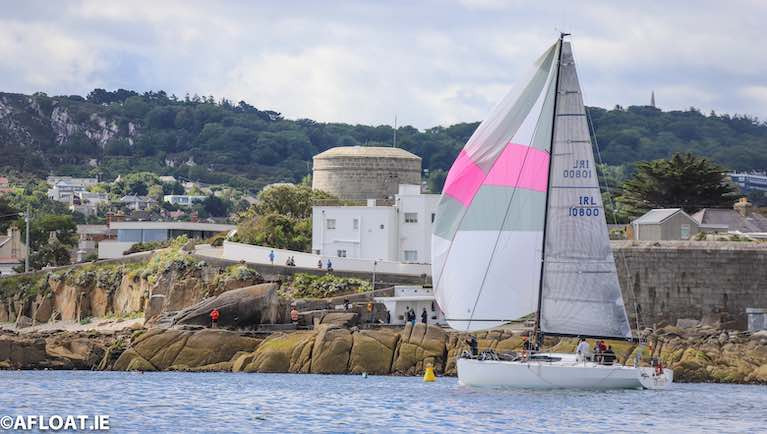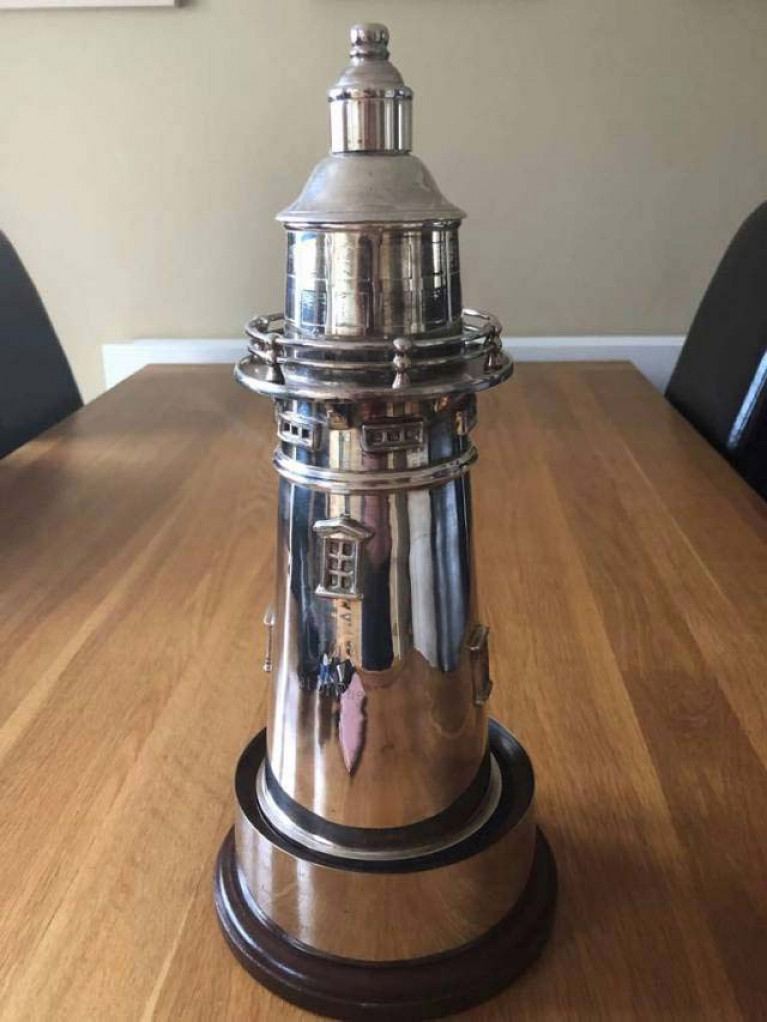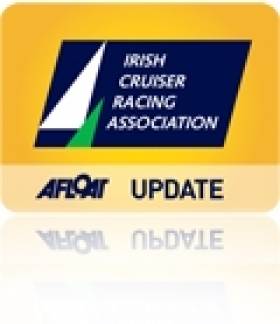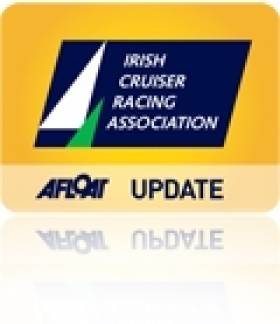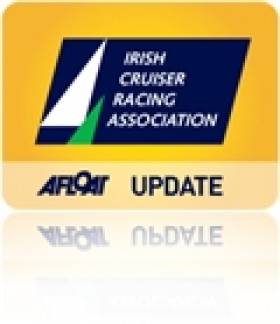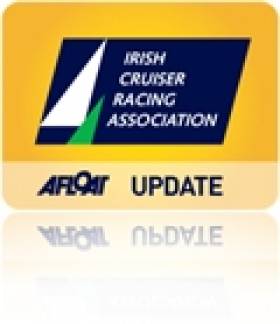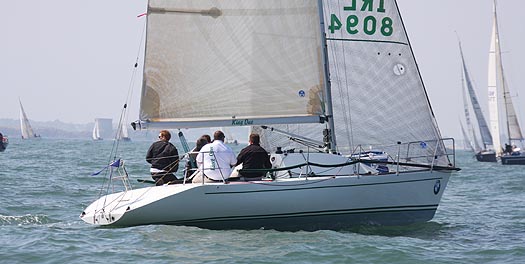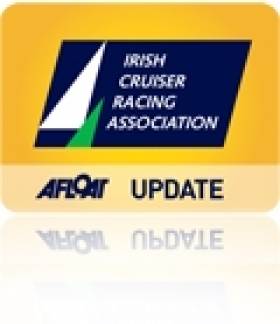Displaying items by tag: Boat of the Year
Greystones J122 Kaya Leads But Royal Cork's Autumn League May Decide ICRA Boat of the Year 2021 Winner
Thanks to wins at the ICRA National Championships and Calves Week, Greystones based Kaya currently sits on top of the ICRA BoTY rankings on 10.5 points but this weekend's RCYC Autumn League (preview here) may yet decide the winner of ICRA Boat of the Year 2021.
The next three boats behind her have each gained 9 points in markedly different ways.
Quarter Tonner Snoopy dominated Class 3 at the ICRA National Championships and placed second in Calves Week.
 ICRA Debutante Snoopy won Class 3 at the ICRA National Championships in September and placed second in Calves Week in August Photo: Afloat
ICRA Debutante Snoopy won Class 3 at the ICRA National Championships in September and placed second in Calves Week in August Photo: Afloat
Cork-based Nieulargo won the Dun Laoghaire to Dingle Race and then placed second in Class at June's Sovereigns Cup at Kinsale.
 Dun Laoghaire to Dingle Race winner Nieulargo also placed second in Class at June's Sovereigns Cup at Kinsale Photo: Bob Bateman
Dun Laoghaire to Dingle Race winner Nieulargo also placed second in Class at June's Sovereigns Cup at Kinsale Photo: Bob Bateman
2019 Boat of the Year, Rockabill VI’s results include Overall Winner in the ISORA Coastal Series together with second place in the D2D and DBSC Thursday series.
 2019 Boat of the Year, Rockabill VI Photo: Afloat
2019 Boat of the Year, Rockabill VI Photo: Afloat
Of the remaining boats still in contention, HYC’s J/109 Storm and white sails contender Prince of Tides both sit on 7.5 points.
In 2019, the HYC Autumn League sealed the deal for Rockabill VI. In 2021 it could yet be the RCYC Autumn League that nudges Nieulargo ahead of Kaya for final honours.
Full scores (computed by ICRA) are downloadable below as an Xcel file.
Having recovered from the recent gruelling Fastnet Race, Royal Cork yacht Nieulargo continues to top the scoreboard for ICRA’s Boat of the Year Award.
According to the latest rankings released by ICRA (on August 20) the Grand Soleil 40 Nieulargo (Denis and Annamarie Murphy) remains at nine points and is followed by another Irish Fastnet Race competitor, Desert Star Irish Offshore Sailing that recorded a top class result, scoring second in division four in the ocean classic.
There are still several boats in contention for the ICRA top boat award given the ICRA Nationals, WIORA, ISORA, DBSC Thursday Series, HYC & RCYC Autumn Leagues are all yet to be completed.
The latest scores are listed below:
ICRA Boat of the Year points
- Nieulargo 9
- Desert Star Irish Offshore Sailing 6
- Juggerknot II 6
- Coracle VI 4.5
- Samatom 4.5
- Shillelagh 4.5
- Slack Alice 4.5
- Snapshot 4.5
- YaGottaWanna 4.5
- Freya 4
- Humdinger 4
- Indian 4
- Rockabill VI 4
ICRA Will Not Award Its Boat of the Year Prize in 2020
With the loss of the key cruiser-racer events in 2020 Irish Cruiser Racing Association (ICRA) Commodore Richard Colwell says the association is unable to award its annual Boat of the Year prize.
As well as its own ICRA National Championships, June's Round Ireland Race, July's Cork Week, September's Wave Regatta and WIORA in Tralee were among some of the big casualties in the Irish sailing scene due to COVID.
ICRA is expected to a new schedule of events for its Boat of the Year Award early in 2021 even though the body has already made a pre-emptive move and rescheduled its 2021 National Championships from May to September as Afloat reported here.
"Hopefully, 2021 will shape up to be a normal season, albeit a "new normal", Colwell says.
ICRA's Boat of the Year Award for 2020 to be 'Kept Under Review'
Last week's high-powered ICRA executive meeting took the decision to cancel its original Boat of the Year schedule faced with material changes to the sailing season over COVID-19.
'Once we get clarity on what events will be proceeding, we will reissue a revised Notice of Race', ICRA Committee member Dave Cullen told Afloat.
The original aim was to ensure all boats have an equal chance at winning the trophy it would be based on each boats best four results across events specified in the NOR.
As regular Afloat readers will know, the original NOR schedule published in December 2019 started with the then ICRA Nationals being hosted by Cork Week in 2020. West Cork's Calves Week was added to the BOTY schedule in order to balance WAVE Regatta on the east coast. At approximately 180 miles, the return of the Dún Laoghaire to Cóbh race, feeding into Cork Week, was also recognised by ICRA as a national event for the purposes of its boat of the year award but now, sadly, that plan has all had to be scrapped.
The cruiser-racer body revamped its boat of the year award in 2019 to be formula-based rather than a traditional committee decision.
Last week's ICRA executive also voted to move this year's national championships to race as part of WAVE Regatta this September after the cancellation of Cork Week 2020.
Victorious Commodore's Cup Team Saluted With ICRA Boat of Year Award
#cruiserracing – Ireland's three boat team that scored the most comprehensive victory in the 22–year history of the Commodores' Cup were saluted in Galway Harbour at the national cruiser conference yesterday when they lifted ICRA's Boat of the Year award. It was a fitting reward for a team that finished the international team regatta on 268 points, with an unprecedented lead of 173.5 points.
The tale of how the 2014 Commodores' Cup was won was related in full by team captain Anthony O'Leary to WM Nixon immediately after the victory here.
The unrivalled performance that saw the team climb to the top of the ranking early in the competition.
Described as one of the most 'clinically focussed keelboat Irish teams', the three boats Antix (Anthony O'Leary), Quokka (Neil Dowling and Michael Boyd) and Mark Glimcher's Catapult left no stone unturned showing total commitment to optimising their boats so they were fully prepared to arrive at the start line in optimum set up.
ICRA contributed by managing to bring to the team the most sought after weather and tidal expert Mike Broughton, who acted as overall team coach at the event. This role was pivotal in maintaining the focus of the team. Supporting the team in Cowes was ICRA flag officers Fintan Cairns, Norbert Reilly and Barry Rose.
Meanwhile, details of the 2015 ICRA Nationals to be sailed in conjunction with Kinsale's Sovereign's Cup were presented to the Galway conference. The 2015 ICRA Notice of Race can be downloaded here.
Nominations Open For ICRA Boat Of The Year 2013
#ICRA - Nominations are now open for the Irish Cruiser Racing Association's (ICRA) Boat of the Year for 2013.
The winner of the award will be announced at the ICRA Conference on Saturday 23 November in the Royal Irish Yacht Club in Dun Laoghaire, which will gather sailors across Ireland involved in handicap sailing to discuss the year's developments.
As previously reported on Afloat.ie, the conference will also be headed by a keynote presentation by Yachting World's technical editor Matt Sheahan on foiling with the America's Cup.
Nominations for the Boat of the Year accolade will be accepted until 23:59 on Friday 22 November and can be submitted online HERE.
NUI Galway Campaign Awarded ICRA's 2012 Boat of the Year Trophy
#boatofthe year – The NUI Galway campaign sailing Martin Breen's Galway Reflex 38 yacht has been named ICRA's Boat of the Year. The prize was presented in Kilkenny this afternoon and applauded by a wide cross section of delegates at the one day ICRA conference including leading sail makers, race organisers, Olympic race officer Jack Roy and Volvo Ocean Race (VOR) champion Damian Foxall.
The NUI campaign was picked ahead of six other boats shortlisted for the prize.
NUI Galway campaign manager Cathal Clarke said the boat's aim in 2012 was to inspire other sailors from the West Coast to undertake similar projects and for the next generation of Volvo Ocean Race sailors to get out there and get sailing.
The ICRA Judges said the student based campaign embodied the spirit of ICRA with a campaign that featured competition in many venues around the country.
Following an overall win in the 2011 Dun Laoghaire to Dingle Race as 'Galway Harbour' Martin Breen's Reflex 38 was prepared for the 2012 Round Ireland by students of NUIG and raced as 'NUIGALWAY'. The students won Class 2 and were the first Irish fixed keel boat, finishing sixth overall.
They were also class 1 winners in the Pwllheli to Wicklow ISORA race in preparation for June's Round Ireland race.
The boat is raced by a separate inshore crew and in 2012 they competed in the 2012 ICRA Nationals in Howth, Cork Week and Calves Week. In 2013 they will plan to race at the ICRA Nationals in Fenit and also in the Sovereigns Cup in Kinsale.
The NUI Galway Round Ireland crew were Ben Scallan (helm), Eoghan McGregor (helm), Joan Mulloy (trimmer), Mark Armstrong (trimmer), Cathal Clarke (trimmer), Back row (left to right) Eoin Breen (bowman), Conor Kinsella (Mainsail trimmer), David Fitzgerald, (bowman), Louis Mulloy (bowman) and Ruaidhri De Faoite (mainsail trimmer).
One of the main aims of NUI campaign was to promote the home-grown sailing talent in Galway. Boat skipper, Cathal Clarke said: "The vision of this project is to prove the wealth of sailing talent here on the west coast and to encourage the next generation of Volvo Ocean Race sailors to get out there and get sailing. We aim to inspire other sailors from the region to undertake such projects in the future."
Who Will Win ICRA's Irish Boat of the Year Award?
#icra – Top handicap cruisers from the popular sailing centres of Howth, Rush, Cork, Galway and Dublin Bay are in the running for ICRA's Boat of the Year award on Saturday and competition judges have already stated a 'special performance' will be required to win the top prize.
Saturday's ICRA conference has an ambitious agenda covering many important topics for the 2013 cruiser racer season ahead, not least the national championships in Tralee and the election of a new Commodore but by 4pm the delegates attention will turn to the Boat of the Year award, an ICRA highlight.
From a short-list of an X-34, two J109s, a Corby 33, two modified quarter tonners, a half tonner and a Ker 39 what boat will win? Afloat.ie review the season highs of each of the nominated campaigns (and in no particular order).
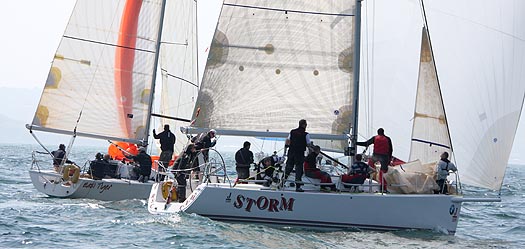
Storm II (J109) Pat Kelly, Rush Sailing Club
Reigning ICRA Boat of the Year Storm II might have lost its ICRA National crown in 2012 but Pat Kelly struck was a very close series on an analysis of the results they lost the entire series by just 10 seconds on the last race. Storm II headed for Scotland following the ICRAs and took their best result on Loch Fyne finishing third on count back.
Back in Dublin Kelly scored his first overall win in 30 years of competing in Howth's Lambay Race. Following this Storm II took honours at the RIYC Regatta in Dublin Bay, bringing the trophy northside. There were also ins in Malahide and Skerries Regattas followed by another win in the September RIYC Regatta. To finish the year off we took five wins and a second in the in Howth Autumn League taking the trophy for the third time in three years and winning overall boat of the series.

Xtravagance (X34) Colin Byrne, Royal Irish Yacht Club
By his own admission the skipper of Xtravagance Colin Byrne says his Dublin Bay based X-34 'didn't have a bad season but equally, we didn't achieve what we wanted to achieve which was to win the ICRAs and to be the top keel boat in Dublin Bay' as they were in 2011. The Royal Irish yacht's results were results included second overall in IRC in the ICRAs and third overall in ECHO.
On Dublin Bay the crew were first overall on Saturdays in DBSC racing in IRC and third overall on Thursdays in IRC. They were second overall on Echo on Saturdays in DBSC. Full DBSC results here for 2012.
The boat also won IRC in the DMYC Regatta and also won the Royal St. George Regatta.
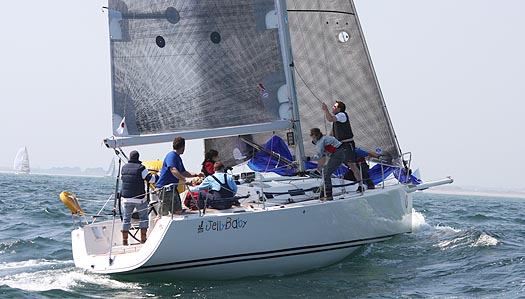
Jelly Baby (J109) Ian Nagle, Royal Cork Yacht Club
The J109 Jelly Baby won a very competitive class at the ICRA Nationals. She also won her class in Cork Week and the J109 Nationals raced as part of the ICRA event and the J109 European title as part Cork Week. Although there were only 4 J 109s in Europeans it was nevertheless a dogfight and only won on the last race on the last day, one of the reasons the Ian Nagle and Paul O'Malley skippered boat has been awarded Royal Cork's own boat of the year trophy.
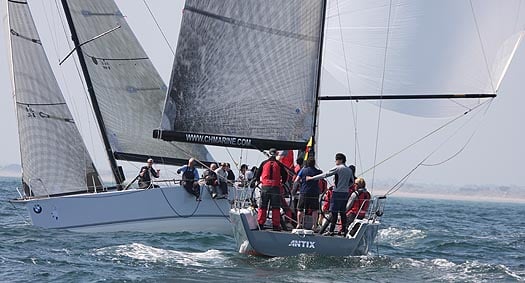
Antix (Ker 39) Anthony O'Leary, Royal Cork Yacht Club
The Captain of ICRA's victorious Commodore's up team in 2010 won the 2012 Easter Series on the Solent. The Ker 39 won Class 0 in the ICRA Nationals in Howth and was successful again on the Solent coming second in the RORC UK IRC Champs. The Anthony O'Leary skippered boat from Royal Cork was also fourth in class at July's Cork Week.

Tiger (Quarter Tonner) Neil Kenefick, Royal Cork Yacht Club
The Kenefick family quarter tonner won her class at the ICRA Nationals in Howth and abroad retained the Corinthian section at the Quarter Ton Worlds on the Solent. This Royal Cork Yacht set out to defend her title and did so in style with her young crew led by George Kenefick (ably assisted by Mike Budd), leading the fleet with five first places and a black flag.
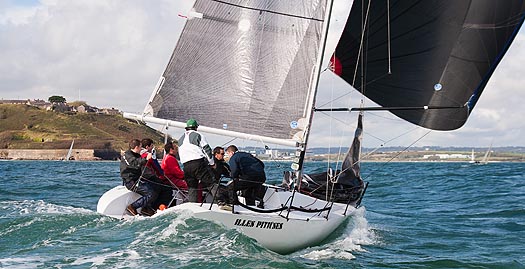
Illes Pitiuses (Quarter Tonner) Losty Bros, Cove Sailing Club
Illes Pitiuses is a modified Quarter Tonner brought back from the Mediterranean by Jason and Dominic Losty last year. The Fauroux design was renovated in Cowes in the Spring of this year. She was second Corinthian Boat behind Tiger at the Quarter Ton Cup in Cowes in it's first major outing, coming 11th overall.
The Cove boat Won Class II at Calves Week and the overall trophy for the Week. She Won Class III and the Moonduster (all-in IRC) Trophy at the Cobh-Blackrock SCORA Race in Cork Harbour.
Illes Pitiuses topped Class II and won the Qaurter Ton Class at the RCYC Autumn Regatta and placed third in the SCORA League despite completing only half the season in Ireland.
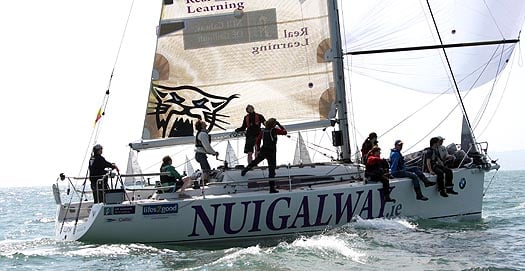
NUI Galway (Reflex 38) Martin Breen, Galway Bay Sailing Club
Following an overall win in the 2011 Dun Laoghaire to Dingle Race as 'Galway Harbour' Martin Breen's Relfex 38 was prepared for the 2012 Round Ireland by students of NUIG and raced as 'NUIGALWAY'. The students won Class 2 and were the first Irish fixed keel boat, finishing sixth overall and winners of the ICRA Cup.
They were also class 1 winners in the Pwllheli to Wicklow ISORA race in preparation for June's Round Ireland race.
The boat is raced by a separate inshore crew and in 2012 they competed in the 2012 ICRA Nationals in Howth, Cork Week and Calves Week. In 2013 they will plan to race at the ICRA Nationals in Fenit and also in the Sovereigns Cup in Kinsale.
Offshore the next events planned for this well sailed Relfex 38 are the 2013 Dun Laoghaire to Dingle race, a RORC Channel race followed by the 2013 Fastnet race.
King One (Half Tonner) Dave Cullen, Howth Yacht Club
Dave Cullen's King One did some travelling around this year summarised as follows: the RORC Easter Regatta in Cowes coming third in a Class of 4B in April. At the ICRAs of home waters King One came third in a fleet of 29 boats. It was followed up at the Howth YC regatta next with a third.
Cullen Headed back to UK to compete against the top Belgian half tonners and competed as part of Class 3 at Ramsgate week. They won the initial coastal series, then the Sail East series, the Half Ton Cup and then followed this up with a win in the overall event as the best scoring boat.
King One returned to Ireland for the HYC Autumn League finishing second.
Next year King One is heading overseas on a French campaign.
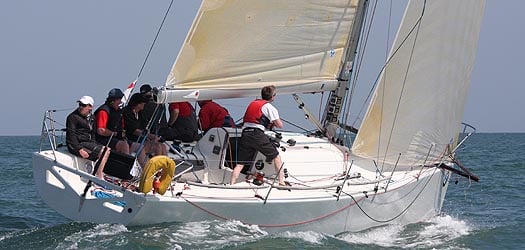
Rockabill (Corby 33) Paul O'Higgins, Royal Irish Yacht Club
Rockabill V boat boss John Kelly has expressed some surprise at his own boat's nomination adding that the Royal Irish YC entry had an 'uneventful season'. The Corby 33 was second in Howth's Corby Cup, third in IRC one at the ICRA nationals, second at the National Yacht club regatta, second to Gloves Off in Calves Week and second in the RIYC end of season regatta.
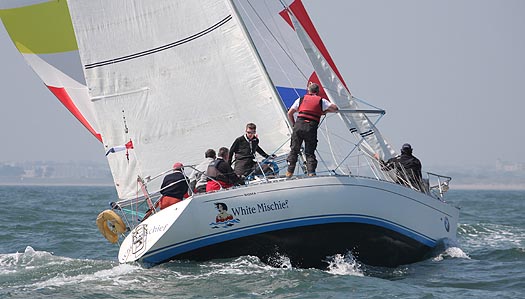
White Mischief (Sigma 33) Tim Goodbody, Royal Irish Yacht Club
Taking time out from her one design performance as the boat to beat in the Sigma 33 class on Dublin Bay, Tim Goodbody's White Mischief came to the ICRA Championships in Howth as a Class 3 and won the Echo division and finished second on IRC. The boat resumed its usual one design position winning her class at the Irish Nationals. In Wales the Royal Irish Yacht took eight wins from eight races at Abersoch Week. On home waters White Mischief took overall wins in the DBSC Thursdays and Saturdays series too.
#icra – Nominees for ICRA's Boat of the Year for 2012 include the reigning champion boat, Pat Kelly's Storm, a J109 from Rush and Howth. Also in the running is Martin Breen's Reflex 38 from Galway Bay Sailing Club sailed this season as 'NUI Galway' but ICRAs Denis Kiely says the ultimate winner of the award to be made at the ICRA conference on November 17 will be the boat that demonstrates an 'extraordinary' year. The 2012 nomination list released by ICRA is below.
There are three Royal Cork boats nominated and two from the Royal Irish Yacht Club.
George Kenefick's modified quarter tonner Tiger is in the running too after its performance in Howth at the ICRA National Championships in May and its Corinthian win of the Quarter ton Cup in the UK
Dave Cullen's modified half tonner King One is also nominated. The Howth yacht captured a huge haul of trophies at Ramsgate week.
'What did each boat do that lifts it out of the pack and places it above all others in 2012 will be a deciding factor says Kiely.
'If there is something special that deserves to be recognised then a headcount of wins in various regattas may not be the determining factor' he adds.
Kiely says there are two stages in the judges decision process. Does the boat have a good season record at national level i.e. performance in a series of top level regattas, and then what is special that makes it worthy of the overall accolade?
Kiely points to the fact that when the original Boat of the year award was made to Voodoo Chile in 2006. 'It was its Round Ireland race win that made it special - a 32 ft boat winning the RI overall. Of course she also had a big programme besides this that but it was the RI win that was special that year' he says.
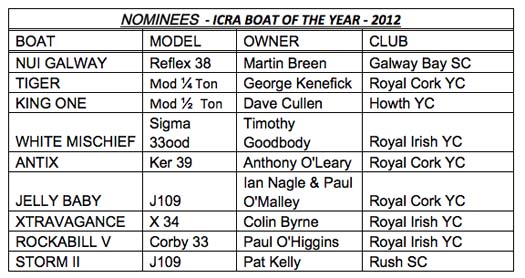
Storm Wins ICRA Boat of Year Award
As predicted in Afloat's online reader poll Howth Yacht Storm (Pat Kelly) has lifted the Irish Cruiser Racer Association's Boat of the Year award at this afternoon's ICRA conference in Dun Laoghaire.
Among other wins, the J109 design counted five firsts in an impressive vistory in class one IRC at this year's ICRA Nationals held in Crosshaven.
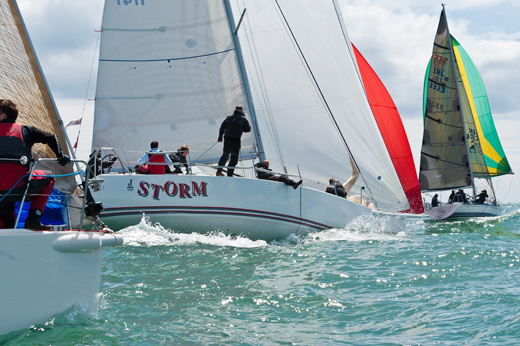
Boat of the Year Storm in winning style. Photo: Bob Bateman




























